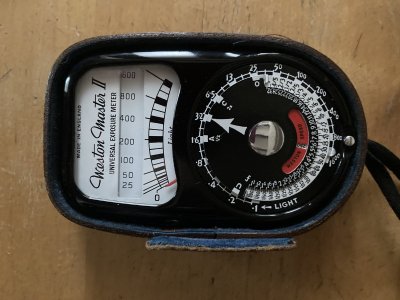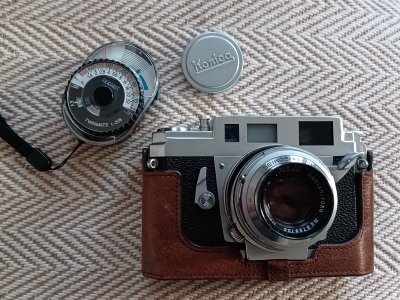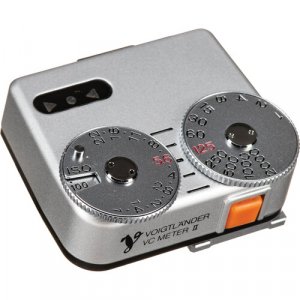furcafe
Mentor
Gossen meters are big and heavy. Some are as large as 35mm cameras I own.
Instead I prefer to use an inexpensive late model Sekonic CdS exposure meter.
Chris
Before posting here, I was considering using one of my smaller, lighter AF 35mm cameras to serve as a meter (Nikon N80 or Pentax Super Program). It would be roughly the size of a large meter.
Not all Gossens are big. The Digisix & Digiflash (same size) are tiny, as shown in Deardorff38's photo, though they aren't quite as sensitive in super low-light like the LunaPro, etc., which are indeed almost as big as a 1990s point & shoot.
hap
Well-known
Yes, it doesn't fit perfectly with the adapter but it does work. I'm not savvy enough to adjust the adjustments although I suspect it is not difficult. the battery test seems straighforward......you put a 1.5V battery and turn the screw one way or another until the test needle rests in the correct place. The other two adjustments ...I am not familiar how to change unless it requires validation with good meter.Should but really doesn't fit well. I had the same problem with the Leicaflex SL or SL2.. can't recall which one.
To adjust the meter you take off the bottom strap lug and the adjustment pots are right there.

hap
Well-known
I have an SL.....doesn't that require the replacement of a diode in the circuit?Yes, it doesn't fit perfectly with the adapter but it does work. I'm not savvy enough to adjust the adjustments although I suspect it is not difficult. the battery test seems straighforward......you put a 1.5V battery and turn the screw one way or another until the test needle rests in the correct place. The other two adjustments ...I am not familiar how to change unless it requires validation with good meter.
shawn
Mentor
The total adjustment is what you want. It will shift the total exposure up or down. If you then find that the response if off on one end or the other you can tweak that with the linearity pot.Yes, it doesn't fit perfectly with the adapter but it does work. I'm not savvy enough to adjust the adjustments although I suspect it is not difficult. the battery test seems straighforward......you put a 1.5V battery and turn the screw one way or another until the test needle rests in the correct place. The other two adjustments ...I am not familiar how to change unless it requires validation with good meter.
shawn
Mentor
That is what I did as the MR-9 didn't really fit.I have an SL.....doesn't that require the replacement of a diode in the circuit?
Leicaflex SL diode install
The MR-9 battery adapter fits the Leicaflex SL2 but doesn't really fit my Leicaflex SL. Decided to just open it up and install a BAT83 schotty diode to drop the meter voltage down to compensate for not using a mercury battery in it. Very easy to do and plenty of room to work around the battery...
 rangefinderforum.com
rangefinderforum.com
Paul T.
Mentor
I've used various Gossen, Luna Pro, voigtlander clip on. Finally discovered the Sekonic 208, perfect balance of being compact but quick/easy to use.
Coldkennels
Barnack-toting Brit.
...I'm a little surprised there's been no mention of these yet:

Solid and hardy little things. No fuss. Incredibly helpful readout, especially if you're using older gear with pre-standardisation shutter speeds or apertures. Built-in zone system markings (with U and O representing Zone I and Zone VIII respectively). Good down to EV 3 at 100 ISO with no batteries. And, at least here in the UK, cheap and plentiful; I've never spent more than £10 on one. You might pay a little more if you want the Invercone adapter too, but I've literally never needed mine. The best bit is they're pretty small by meter standards - 95 x 54 x 21mm without the case - so it's easy to carry everywhere in a front pocket.
When things become too dark for the Weston, I pull out an iPhone app. But in 99% of scenarios, the Weston gets things done.

Solid and hardy little things. No fuss. Incredibly helpful readout, especially if you're using older gear with pre-standardisation shutter speeds or apertures. Built-in zone system markings (with U and O representing Zone I and Zone VIII respectively). Good down to EV 3 at 100 ISO with no batteries. And, at least here in the UK, cheap and plentiful; I've never spent more than £10 on one. You might pay a little more if you want the Invercone adapter too, but I've literally never needed mine. The best bit is they're pretty small by meter standards - 95 x 54 x 21mm without the case - so it's easy to carry everywhere in a front pocket.
When things become too dark for the Weston, I pull out an iPhone app. But in 99% of scenarios, the Weston gets things done.
Gordon Moat
Established
I have a Sekonic L-358 that I’ve used for many years professionally. It’s great for multiple lighting setups, or balancing strobe with ambient. Probably too much for daylight shooting.
On my Nikon S3 2000 and Leica M4-2, I use a Doomo Meter S on each. It’s very compact, USB-C rechargeable, and reasonably accurate.
On my Nikon S3 2000 and Leica M4-2, I use a Doomo Meter S on each. It’s very compact, USB-C rechargeable, and reasonably accurate.
Attachments
Darthfeeble
But you can call me Steve
I have a Sekonic 308s which is a dash larger than a pack of cigs and will do flash, show exposure in f stop/shutter speed or in EV level which is handy if you have a Hasselblad laying around. Uses a single AA battery and comes with a belt pouch. I don't remember the price but it isn't too much or I wouldn't have bought it.
Ko.Fe.
Lenses 35/21 Gears 46/20
If you like it old fashioned, but functional - Seconic twinmate, if I'm not mistaken. I have not used it long time. The reason? Telephones are equiped with cameras. They are crappy cameras, but accurate light meters. It is only matter to find version of application, which works. Those which shows you liveview and allows meter any spot on the screen are smarter.
I used it for half a year and realized I don't need to meter anything, because I already know. Including, so called low light.
I used it for half a year and realized I don't need to meter anything, because I already know. Including, so called low light.
hap
Well-known
is there a silver oxide of the correct form factor for the M5?The total adjustment is what you want. It will shift the total exposure up or down. If you then find that the response if off on one end or the other you can tweak that with the linearity pot.
shawn
Mentor
The non-diode adapters are shaped slightly differently and fit a bit better. Plus I sanded it slightly for a better fit.is there a silver oxide of the correct form factor for the M5?
Tim Murphy
Well-known
Dear Shawn,The non-diode adapters are shaped slightly differently and fit a bit better. Plus I sanded it slightly for a better fit.
I've been using alkaline PX625's in a Nikon FTN and a Nikkormat FTN for years with no real issues. I use zinc-air 675 hearing aid batteries in my Canon F-1 and alkaline PX625's in my Canon EF.
For giggles and grins, I just checked exposures out my den window with 5 cameras and a known good light meter. ISO was set 200, aperture at f2, and shutter speed was determined by matching the needle or reading the digital read-out.
Nikon FTN with alkaline PX625's when set at f2 showed a shutter speed of 1/30
Nikkormat FTN with alkaline PX625's and f2 showed a shutter speed of 1/30
Canon F-1 with brass spacer adapter and zinc-air 675 hearing aid battery at f2 showed a shutter speed of 1/15
Canon EF with alkaline PX625's when set at 1/30 indicated an aperture of f2
Panasonic FZ300 when set at 50mm focal length and f2 showed a shutter speed of 1/20
Gossen Luna-Lux SBC matched at f1.8 and 1/30 - if I interpolate the hash marks on the meter it matches the FZ300 exactly.
My point being is that all of meters regardless of the battery power supplied to them are well within acceptable range for use with negative film.
Close enough for me!
Regards,
Tim Murphy
Harrisburg PA
shawn
Mentor
Sone meter designs are not effected by voltage differences. Some are. My Leicaflexs were off by about two stops before I did the diode mod.Dear Shawn,
I've been using alkaline PX625's in a Nikon FTN and a Nikkormat FTN for years with no real issues. I use zinc-air 675 hearing aid batteries in my Canon F-1 and alkaline PX625's in my Canon EF.
For giggles and grins, I just checked exposures out my den window with 5 cameras and a known good light meter. ISO was set 200, aperture at f2, and shutter speed was determined by matching the needle or reading the digital read-out.
Nikon FTN with alkaline PX625's when set at f2 showed a shutter speed of 1/30
Nikkormat FTN with alkaline PX625's and f2 showed a shutter speed of 1/30
Canon F-1 with brass spacer adapter and zinc-air 675 hearing aid battery at f2 showed a shutter speed of 1/15
Canon EF with alkaline PX625's when set at 1/30 indicated an aperture of f2
Panasonic FZ300 when set at 50mm focal length and f2 showed a shutter speed of 1/20
Gossen Luna-Lux SBC matched at f1.8 and 1/30 - if I interpolate the hash marks on the meter it matches the FZ300 exactly.
My point being is that all of meters regardless of the battery power supplied to them are well within acceptable range for use with negative film.
Close enough for me!
Regards,
Tim Murphy
Harrisburg PA
stephen_lumsden
Well-known
If you are just starting out and mainly do black and white, a Leningrad 4 is cheap and cheerful. I have a have a couple and also have a sekonic l-28 A2 incident meter for more challenging light.
Chriscrawfordphoto
Real Men Shoot Film.
...I'm a little surprised there's been no mention of these yet:
View attachment 4825178
Solid and hardy little things. No fuss. Incredibly helpful readout, especially if you're using older gear with pre-standardisation shutter speeds or apertures. Built-in zone system markings (with U and O representing Zone I and Zone VIII respectively). Good down to EV 3 at 100 ISO with no batteries. And, at least here in the UK, cheap and plentiful; I've never spent more than £10 on one. You might pay a little more if you want the Invercone adapter too, but I've literally never needed mine. The best bit is they're pretty small by meter standards - 95 x 54 x 21mm without the case - so it's easy to carry everywhere in a front pocket.
When things become too dark for the Weston, I pull out an iPhone app. But in 99% of scenarios, the Weston gets things done.
Virtually all old Weston meters found in the US are dead. I've seen a few that responded to light but were several stops out of calibration. I have a Master V that was rebuilt by Ian Partridge, but honestly it is too expensive for what it offers. Compared to a modern meter it is not very accurate, has poor low light sensitivity, is delicate, and too expensive for one that has been serviced to make it usable.
Coldkennels
Barnack-toting Brit.
I've fixed a few myself over the years. Claims of weak or totally dead selenium cells are usually overblown (although it does happen). Usually it's just oxidised contacts, and cleaning them up and/or resoldering them brings them back to life. My absolute favourite is when people say they're not accurate when they've set it to the wrong film speed; a Weston I and II needs to be set two notches lower than the ISO (Weston 64 = 100 ISO), later ones are one notches below (Weston 80 = 100 ISO). You'd be surprised how many "inaccurate" Westons are just down to that issue.Virtually all old Weston meters found in the US are dead. I've seen a few that responded to light but were several stops out of calibration. I have a Master V that was rebuilt by Ian Partridge, but honestly it is too expensive for what it offers. Compared to a modern meter it is not very accurate, has poor low light sensitivity, is delicate, and too expensive for one that has been serviced to make it usable.
I find the IV and V are most problematic, as the bar that traps the needle to lock the exposure is often a source of issues. The III is a sweet spot in build quality and readability, I find. Other than the revision in Weston Ratings, there's not much difference between that and the II other than the readout is a bit faster to decipher on the III. Either one in good condition makes a great meter.
The real problem is smashing the front glass and damaging the needle. I've only done that once before - had one in my pocket while moving heavy stuff around - and felt like a complete idiot. In every day use it's never been a problem.
largedrink
Down Under
I have used a Gossen Sixtino for the past 5 or so years, small and very light. I just upgraded to a Sekonic Twinmate L-208, because it's a similar form factor with larger font. The Twinmate takes a battery, whereas every other light meter I own doesn't. I haven't used it yet. Here it is next to another new purchase.


dave lackey
Mentor
dave lackey
Mentor
I am still considering it for use with my black FTN (now with a wonky meter)…but I haven’t given up on it yet!😃
Share:
-
This site uses cookies to help personalise content, tailor your experience and to keep you logged in if you register.
By continuing to use this site, you are consenting to our use of cookies.



